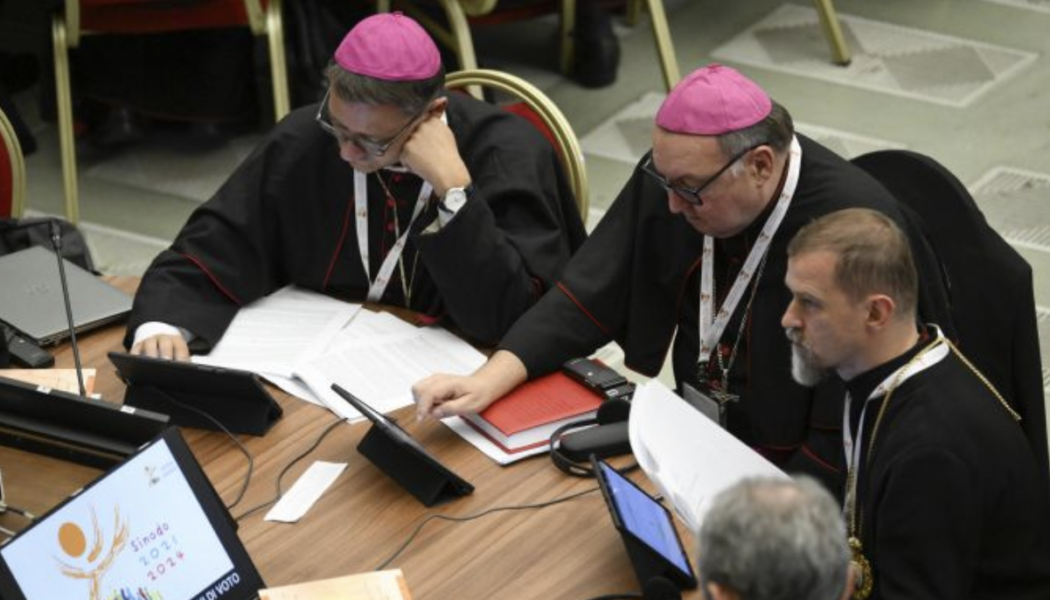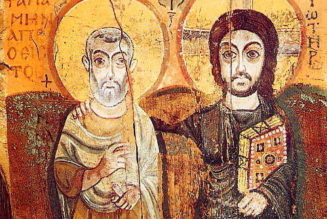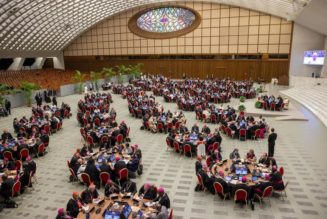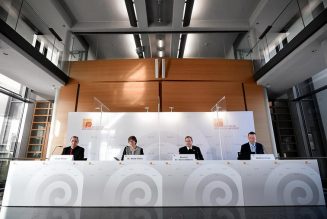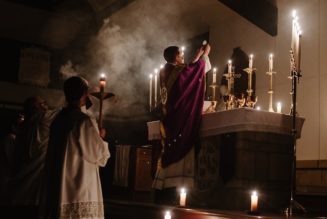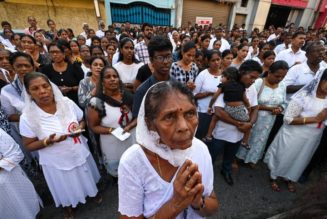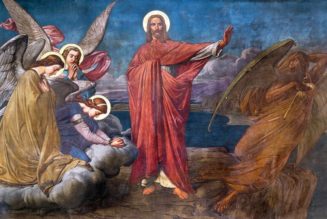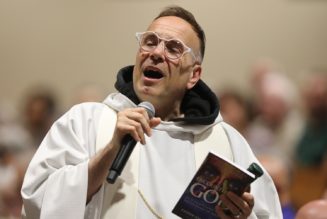
Sometimes the boring stuff is the most important. Anyone who has ever worked in journalism for several decades, such as myself, can attest to this.
Whether you’re sifting through legal documents or financial statements, there’s more often than not a story — or at the very least some important information that can be used as supporting material — that can be gleaned from such an exercise.
The same often goes for materials and documents released by the Vatican. I often try to read Holy See correspondence in Italian (like the United Nations, the Vatican often puts out information in a variety of languages) on the Vatican website or in its official newspaper l’Osservatore Romano.
But information out of Rome, often resembling a fire hose, was down to a trickle over the past month. That was the story that loomed over the whole Synod on Synodality story.
For several weeks, there were no documents to read through and very few notable news conferences. You ended up with talking points about the lack of talking points. It was, to be blunt, next to impossible to know what was happening. Maybe that was the point?
We know, now that this second phase of the synod has come to an end, that the Vatican issued a document that “said it was ‘urgent’ that women have a larger role but postponed discussion of major issues such as ordaining women as deacons and failed to address outreach to L.G.B.T.Q.+ Catholics.”
That’s what The New York Times reported this past weekend upon the synod’s conclusion. It should be noted that the final phase will take place in October 2024. At that point, recommendations on what doctrinal changes — yes, doctrinal changes — the church should adopt will be put in front of Pope Francis for consideration.
While there was plenty of coverage once the meeting was over, there was little to no coverage of the synod while it was taking place. At least no coverage that informed readers in general, and Catholics in particular, on what was actually going on inside the Vatican these past few weeks. Almost all “information” available was second-hard or from Vatican approved voices. There were no transcripts or videos of crucial speeches, for example.
The reason for all of this was a simple one. Pope Francis wanted a media blackout.
That’s right. A meeting meant to inspire open dialogue was held under a veil of silence. This did not go unnoticed by those of us in the press who cover the church. But some journalists seemed more upset than others.
Writing for the Catholic Herald, Elise Ann Allen noted the following in an Oct. 23 piece:
Perhaps one of the most exciting moments of the Synod of Bishops so far, not to mention one of the most illustrative, took place during a heated exchange between synod organisers and a veteran Vatican reporter over a publicity “fast” called for by Pope Francis during the assembly.
In his opening address for the Oct. 4-29 Synod of Bishops on Synodality, officially titled, “For a Synodal Church: Communion, Participation, Mission”, the pope called for “a certain fast from the public word”, justified as a way to safeguard the objectivity of the discussion.
In effect, it meant the pope was telling participants not to divulge what was going on behind closed doors except those selected by synod officials to take part in carefully choreographed daily briefings in the Vatican Press Office, and even then to speak only in the most general terms.
To justify the cone of silence, Francis cited the influence he felt public opinion had exercised on previous synod gatherings, such as the 2014 and 2015 Synods of Bishops on the Family, when communion for divorced and remarried Catholics was a major talking point, and the 2019 Synod of Bishops on the Amazon, during which the married priesthood was a source of debate.
In both cases, Francis said bishops entered the discussion under the “pressure” of polarised public debate, and thus for this month’s gathering, he wanted to underline “the priority of listening.”
This is exactly what reporters don’t want to hear, especially ones covering a potentially pivotal event such as this one — a synod that could forever change Catholicism.
Not surprisingly, things got testy when reporters covering the synod actually had a chance to ask some questions.
This is what Allen — the wife of the noted Vatican observer John L. Allen, Jr. — also reported in the Catholic Herald:
Those tensions came to a head during an Oct. 17 press conference, when a reporter asked whether participants were aware of the topics being repeatedly asked about by journalists in the daily briefings, if they knew what the major headlines were, and how those issues lined up with priorities inside the synod hall.
In response, Italian layman Paolo Ruffini, head of the Vatican’s Dicastery for Communications and ostensibly the PR czar for the synod, testily responded that synod participants are not “closed off”, and are able to read newspapers and online stories.
“At the same time, we have tried to explain (that) the synod is not (meant) to respond to the questions of one journalist or another. It’s a discernment of the church born of a process … a long process of listening to the whole church in the whole world,” Ruffini said.
He insisted that what’s happening in the synod hall “is not out of touch with the world,” and that participants are routinely praying for world events, such as the outbreak of the war in Gaza.
Finally, Allen also made this astute observation:
In this sense, Pope Francis’s imposition of a media blackout, which perhaps at some level avoids the public exchanging of punches between ideological opponents in the press, has created different tensions.
Reporters have routinely asked about “conspiracies” and impressions that the pope’s “private agenda” is being pushed, or whether a “liberal cabal” is manipulating the discussion to sway it in one way or another.
Rather than taking issues off the table, the press, not knowing what is being said about the hot-button issues being discussed or having access to participants who can shed light, have honed in on a select number of the most polemical issues.
That’s right. The synod — at least for those of us on the outside — did fuel conspiracies.
That’s the last thing this pope or the church needs at a time when our news feeds are loaded with misinformation and conspiracy theories. At the same time, many in press see their role to be one of partisanship rather than informing the public. Also, here at GetReligion, we have — for a year or more — noted that major newsrooms are simply ignoring many important events and trends in Catholic news. Why?
<div class="sqs-block embed-block sqs-block-embed" data-block-json="{"width":550,"height":null,"hSize":null,"html":"
As the Synod on Synodality comes to a close, another claim has been spreading through social media: that the synod has promoted love for demons.https://t.co/RChW3BefS9
— Mike Lewis (@mfjlewis) October 27, 2023
\n","url":"https://twitter.com/mfjlewis/status/1718023894076981334","resolvedBy":"twitter","floatDir":null,"providerName":"Twitter","customThumbEnabled":false}” data-block-type=”22″ id=”block-yui_3_17_2_1_1698629774867_294537″>
As the Synod on Synodality comes to a close, another claim has been spreading through social media: that the synod has promoted love for demons.https://t.co/RChW3BefS9
— Mike Lewis (@mfjlewis) October 27, 2023
Father Thomas Reese — long a trusted source for journalists and a columnist at the Jesuit America magazine — had addressed the media blackout on Oct. 16 that was republished at Religion News Service. This is what he said:
The media, on the other hand, thrives on conflict. You will never read a headline saying, “Participants love one another; everything is fine.”
Covering the Synod on Synodality has been especially difficult. Pope Francis does not like the press, especially the Western media, which, he believes, only writes about issues of concern to the Global North.
Repeat: “Pope Francis does not like the press.”
That’s a rather strongly-worded and candid statement made by a man who typically supports this pontiff. Reese elaborated on that point this way:
Every synod has had an antagonistic relationship with the media. Journalists are suspicious by nature. The media suspects people are hiding something, and the less you give reporters, the more suspicious they become.
“Amen” to that.
So why impose such a blackout on the month-long proceedings? Reese claimed it was so members could speak freely behind closed doors on important issues this synod was tackling, including the blessing of same-sex marriages, more outreach to the LGBTQ+ community and whether divorced couples — whose with secular divorces — should receive Holy Communion.
Reese also noted that by imposing a papal gag order, the press will focus on “sideshows.”
Without anything to write about, the media is giving attention to the sideshows and demonstrations happening outside the synod. I have chosen to look elsewhere, writing about Laudate Deum, the pope’s new document on global warming, or to cover the byplay leading up to the synod: the “dubia,” or questions raised by five conservative cardinals, and the retreat talks given to the synodal members by the Dominican Timothy Radcliffe prior to the synod.
Francis does not understand that, when it comes to the media, you either feed the beast or the beast eats you. You either control the narrative, or the narrative is controlled by anyone who grabs the media’s attention.
This section alone of Reese’s column should be made required reading to the pope and the Vatican press office ahead of next year’s gathering.
Christopher White, the Vatican correspondent at the National Catholic Reporter, filed a wonderful dispatch on Oct. 26, just days before the meeting concluded, gave readers a behind-the-scene look at what had gone on at the synod.
What he reported wasn’t pretty. This is how White opened his piece:
It was less than two weeks into Pope Francis’ high-stakes Vatican summit on the future of the Catholic Church when multiple reports emerged about participating delegates storming out of the room.
In one case, a bishop didn’t want to be photographed sitting next to a priest with whom he had numerous disagreements. In another, a cardinal believed that the Oct. 4-29 Synod of Bishops was a misnomer because it now included the equal participation of the laity — a criticism that has reverberated throughout the monthlong meeting.
The incidents weren’t exactly a surprise, as the roughly 450 bishops and lay delegates taking part in the assembly had been warned by one of the synod’s principal organizers that tensions in the room would emerge.
“We are not afraid of tensions,” Cardinal Jean-Claude Hollerich of Luxembourg told participants on Oct. 9. “Tensions are a part of the process, as long as we consider ourselves to be sisters and brothers, walking together.”
During the second and third weeks of the synodal assembly, issues that include the role of women’s ministries in the church and questions surrounding how to respond to LGBTQ Catholics — as well as the very nature of synodality itself — brought to the surface a number of disagreements among its members.
Inevitably, however, news has leaked out because — gasp! — people involved decided to speak on condition on anonymity. While reporters and editors are aware that unnamed sources should be used sparingly, they had no choice in this case.
More from White about the synod:
One day after hearing accounts of sharp disagreements, I asked one synod member to corroborate some of the things I had heard.
Indeed, it was all true, the person confirmed, adding: “We’re not even at first base here. We can’t even get to discussing many of these issues, because so many people in the room haven’t been trained in the practice of synodality. That’s what this month is providing.”
“So, it’s sort of a boot camp?,” I asked. “Exactly,” they replied.
Some people in the Vatican’s Pope Paul VI hall this month, where the synod is meeting, are here because they wanted to be, while others are here because someone else chose them. It’s a bit like the draft versus voluntary enrollment.
Repeat: “Trained in the practice of synodality.”
At a time when progressives and conservatives inside the church are fighting, wouldn’t it have been healthier for this process — which the pope has said was meant to foster dialogue — to be more transparent. This way, people on both sides of this doctrinal divide could have spoken with more clarity and conviction as to way they believe what they believe?
Instead, we got none of that and the press — grasping for something (anything!) to write about — had nothing concrete to focus on. It truly has meant coverage that focused on, as Reese out it, “sideshows.”
There was several ways the Vatican could have combated this. Instead of a document released at the end of session, why not put out a daily summary or one every few days with an update on what was discussed.
Second, back that paperwork up with news conferences featuring people who disagreed on some of these major issues. If not, then allow them to speak freely to reporters. Not doing so allowed for leaks and unnamed sources. There’s nothing more than some boring paperwork to go over in search for nuggets of news and information during the past four weeks.
Finally, this synod needed less talk about process and more regarding substance. Yes, it’s true that process is one of those boring things reporters need to know about, substance would have at least made the boring stuff more palatable.
FIRST IMAGE: Delegates vote to approve a report at the conclusion of the Synod on Synodality (photo via Vatican Media)
